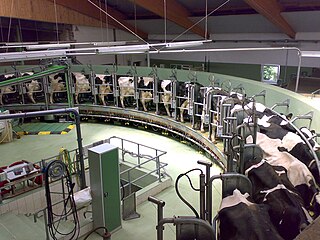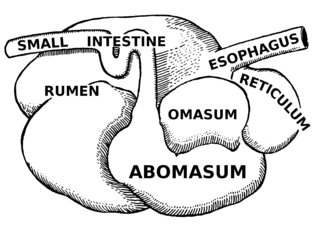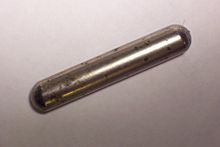
Dairy farming is a class of agriculture for the long-term production of milk, which is processed for the eventual sale of a dairy product. Dairy farming has a history that goes back to the early Neolithic era, around the seventh millennium BC, in many regions of Europe and Africa. Before the 20th century, milking was done by hand on small farms. Beginning in the early 20th century, milking was done in large scale dairy farms with innovations including rotary parlors, the milking pipeline, and automatic milking systems that were commercially developed in the early 1990s.

Dairy cattle are cattle bred with the ability to produce large quantities of milk, from which dairy products are made. Dairy cattle generally are of the species Bos taurus.

An ear tag is a plastic or metal object used for identification of domestic livestock and other animals. If the ear tag uses Radio Frequency Identification Device (RFID) technology it is referred to as an electronic ear tag. Electronic ear tags conform to international standards ISO 11784 and ISO 11785 working at 134.2 kHz, as well as ISO/IEC 18000-6C operating in the UHF spectrum. There are other non-standard systems such as Destron working at 125 kHz. Although there are many shapes of ear tags, the main types in current use are as follows:

Campylobacter fetus is a rod-shaped, gram-negative species of bacteria within the genus Campylobacter of phylum Pseudomonadota. Identification of C. fetus species in infected animals or people is routinely performed by culture on blood or cefoperazone deoxycholate agar. Subspecies of C. fetus commonly causes reproductive disease in ruminants and gastrointestinal disease in humans. Transmission of C. fetus subspecies venerealis occurs mainly through venereal contact while transmission of C. fetus subspecies fetus occurs mainly through ingestion of bacteria in a contaminated environment. Infertility in cattle and abortion in sheep are common outcomes of infection associated with C. fetus subspecies venerealis and C. fetus subspecies fetus, respectively. Disease in humans occurs through zoonotic transmission of C. fetus mainly via ingestion of contaminated food or water sources. C. fetus can be diagnosed with polymerase chain reaction assays, enzyme linked immunosorbent assays and vaginal mucus agglutination testing. As vaccines are typically not efficient in preventing future spread, infected bulls are often culled. Human infections may be treated with erythromycin as antimicrobial resistance has been emerging for the fluoroquinolones.
Bovine alphaherpesvirus 1 (BoHV-1) is a virus of the family Herpesviridae and the subfamily Alphaherpesvirinae, known to cause several diseases worldwide in cattle, including rhinotracheitis, vaginitis, balanoposthitis, abortion, conjunctivitis, and enteritis. BoHV-1 is also a contributing factor in shipping fever, also known as bovine respiratory disease (BRD). It is spread horizontally through sexual contact, artificial insemination, and aerosol transmission and it may also be transmitted vertically across the placenta. BoHV-1 can cause both clinical and subclinical infections, depending on the virulence of the strain. Although these symptoms are mainly non-life-threatening it is an economically important disease as infection may cause a drop in production and affect trade restrictions. Like other herpesviruses, BoHV-1 causes a lifelong latent infection and sporadic shedding of the virus. The sciatic nerve and trigeminal nerve are the sites of latency. A reactivated latent carrier is normally the source of infection in a herd. The clinical signs displayed are dependent on the virulence of the strain. There is a vaccine available which reduces the severity and incidence of disease. Some countries in Europe have successfully eradicated the disease by applying a strict culling policy.

Neospora is a single celled parasite of livestock and companion animals. It was not discovered until 1984 in Norway, where it was found in dogs. Neosporosis, the disease that affects cattle and companion animals, has a worldwide distribution. Neosporosis causes abortions in cattle and paralysis in companion animals. It is highly transmissible and some herds can have up to a 90% prevalence. Up to 33% of pregnancies can result in aborted fetuses on one dairy farm. In many countries this organism is the main cause of abortion in cattle. Neosporosis is now considered as a major cause of abortion in cattle worldwide. Many reliable diagnostic tests are commercially available. Neospora caninum does not appear to be infectious to humans. In dogs, Neospora caninum can cause neurological signs, especially in congenitally infected puppies, where it can form cysts in the central nervous system.
Fog fever is a refeeding syndrome in cattle, clinically named acute bovine pulmonary emphysema and edema (ABPEE) and bovine atypical interstitial pneumonia. This veterinary disease in adult cattle follows an abrupt move from feedlot to 'foggage pasture'. Clinical signs begin within 1 to 14 days and death may follow within 2 to 4 days. The condition can affect up to 50% of the herd, and around 30% of affected cattle may die as a result. This metabolic nutritional-respiratory disturbance has also been reported in other ruminants and on a wide variety of grasses, alfalfa, rape, kale, and turnip tops.
The reticulum is the second chamber in the four-chamber alimentary canal of a ruminant animal. Anatomically it is the smaller portion of the reticulorumen along with the rumen. Together these two compartments make up 84% of the volume of the total stomach.
Bovine leukemia virus (BLV) is a retrovirus which causes enzootic bovine leukosis in cattle. It is closely related to the human T‑lymphotropic virus type 1 (HTLV-I). BLV may integrate into the genomic DNA of B‑lymphocytes as a DNA intermediate, or exist as unintegrated circular or linear forms. Besides structural and enzymatic genes required for virion production, BLV expresses the Tax protein and microRNAs involved in cell proliferation and oncogenesis. In cattle, most infected animals are asymptomatic; leukemia is rare, but lymphoproliferation is more frequent (30%).
Abomasitis is a relatively rare ruminant disease characterized by inflammation of abomasum usually caused by larval development in young calves, lambs, and goat kids. It occurs with gastroenteritis, but can also be a side effect of other diseases. However, it is seldom diagnosed as a separate condition.

Bovine uterine prolapse occurs when the bovine uterus protrudes after calving. It is most common in dairy cattle and can occur in beef cows occasionally with hypocalcaemia. It is not as commonly seen in heifers, but occasionally can be seen in dairy heifers and most commonly Herefords.

A cannulated cow or fistulated cow refers to a cow that has been surgically fitted with a cannula. A cannula acts as a porthole-like device that allows access to the rumen of a cow, to perform research and analysis of the digestive system and to allow veterinarians to transplant rumen contents from one cow to another.

Bovine mastitis is the persistent, inflammatory reaction of the udder tissue due to physical trauma or microorganisms infections. Mastitis, a potentially fatal mammary gland infection, is the most common disease in dairy cattle in the United States and worldwide. It is also the most costly disease to the dairy industry. Milk from cows suffering from mastitis has an increased somatic cell count. Prevention and control of mastitis requires consistency in sanitizing the cow barn facilities, proper milking procedure and segregation of infected animals. Treatment of the disease is carried out by penicillin injection in combination with sulphar drug.

Cattle are large, domesticated, bovid ungulates widely kept as livestock. They are prominent modern members of the subfamily Bovinae and the most widespread species of the genus Bos. Mature female cattle are called cows and mature male cattle are bulls. Young female cattle are called heifers, young male cattle are oxen or bullocks, and castrated male cattle are known as steers.

Metritis is inflammation of the wall of the uterus, whereas endometritis is inflammation of the functional lining of the uterus, called the endometrium. The term pelvic inflammatory disease (PID) is often used for metritis.
Pseudocowpox is a disease caused by the Paravaccinia virus or Pseudocowpox virus, a virus of the family Poxviridae and the genus Parapoxvirus. Humans can contract the virus from contact with livestock infected with Bovine papular stomatitis and the disease is common among ranchers, milkers, and veterinarians. Infection in humans will present with fever, fatigue, and lesion on the skin.

Actinomyces bovis is a branching, Gram-positive, rod-shaped bacterium of the genus Actinomyces. It is the causative agent of lumpy jaw in cattle, and occasionally causes actinomycosis infections in humans. A. bovis normally populates the gastrointestinal tract of healthy ruminants, but is opportunistic in nature and will move into tissues through ulcerations or abrasions of the mucosa to cause infection. The disease occurs when there is physical damage to the tissue of the mouth, allowing the bacteria to colonize the deep tissue and bone, typically affecting the mandible and maxilla. Actinomycosis is pathognomonic for abscesses containing "sulfur" granules, and its colonies appear basophilic with club-shaped reaction products on a histological preparation. Lumpy jaw is commonly treated with broad-spectrum antibiotics with varying success, and can be a major economic loss for producers in countries where it is endemic. Because this organism is zoonotic, it is a human health concern and can cause granulomas, abscesses, skin lesions, and bronchopneumonia.
Mycoplasma bovis is one of 126 species of genus Mycoplasma. It is the smallest living cell and anaerobic organism in nature. It does not contain any cell wall and is therefore resistant to penicillin and other beta lactam antibiotics.

Displaced abomasum in cattle occurs when the abomasum, also known as the true stomach, which typically resides on the floor of the abdomen, fills with gas and rises to the top of the abdomen, where it is said to be ‘displaced’. When the abomasum moves from its normal position it prevents the natural passage of gas and feed through the digestive system, creating a restriction. As cattle are ruminants, which have a 4 chambered stomach composed of a rumen, reticulum, omasum and abomasum. Ruminants require this specialized digestive system in order to properly process and break down their high fiber and cellulose rich diets. As this type of digestive system is quite complex it is at a greater risk for incidence. Due to the natural anatomy of cattle it is more common to have the abomasum displace to the left, known as a left-displaced abomasum, than to the right, right-displaced abomasum. When the abomasum becomes displaced there also becomes a chance of an abomasal volvulus, twist, developing. An abomasal volvulus occurs when the abomasum, which is already out of place, will rotate and cut off blood and nutrient supply to the abomasum. Cattle which develop an abomasal twist require immediate vet attention to regain blood supply and food passage through the digestive system or the abomasum will begin to shut down due to lack of blood supply and toxicity development.

The United Kingdom was afflicted with an outbreak of Bovine spongiform encephalopathy, and its human equivalent variant Creutzfeldt–Jakob disease (vCJD), in the 1980s and 1990s. Over four million head of cattle were slaughtered in an effort to contain the outbreak, and 178 people died after contracting vCJD through eating infected beef. A political and public health crisis resulted, and British beef was banned from export to numerous countries around the world, with some bans remaining in place until as late as 2019.
















